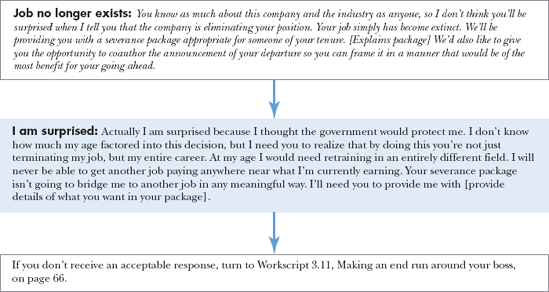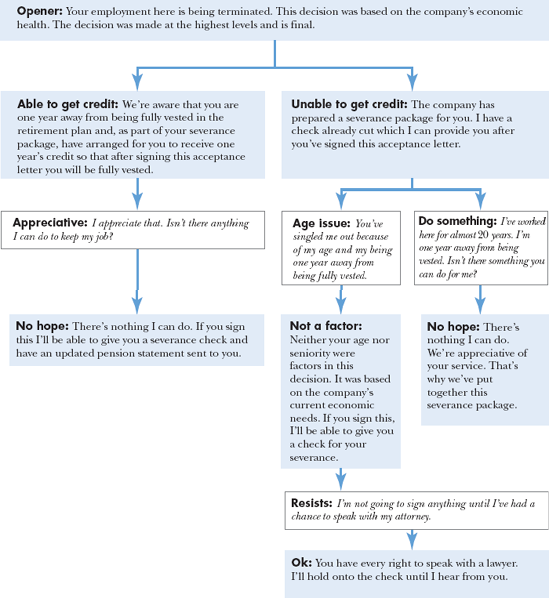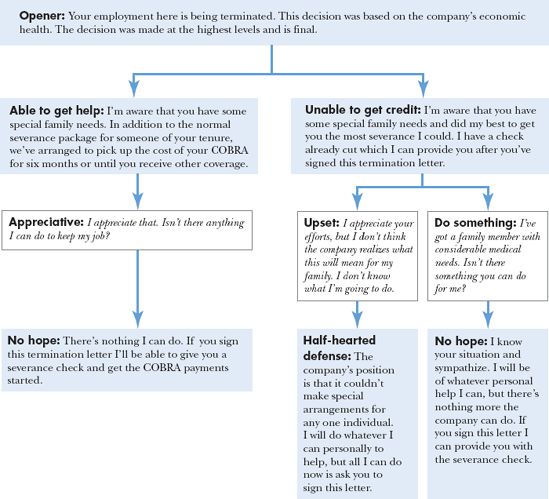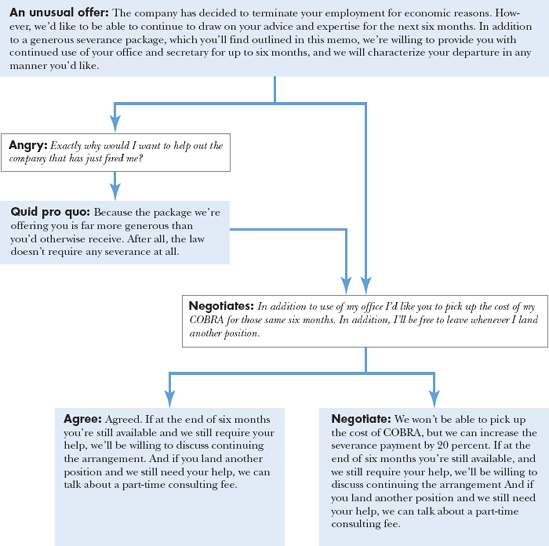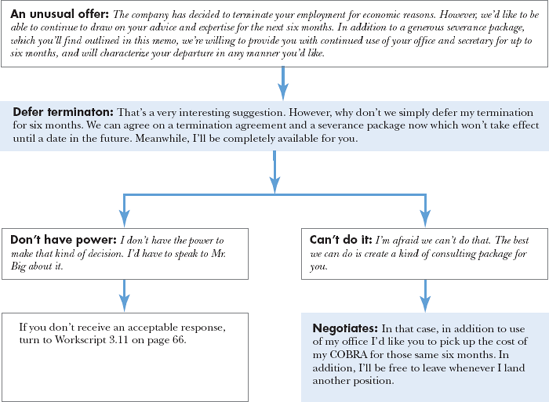One thing that's certainly different in today's workplace is that terminations have become more frequent than in the past. Managers used to be able to go for years without having to deliver a death sentence. Terminating an employee used to be considered a milestone for a young manager, a big step in the process of professional maturation, made even larger because it was so rare. While it's still monumental and traumatic for the employee being fired, it's no longer as significant an event for the manager. That's a shame.
Primarily, it's a shame because it makes management a less humane process. Terminations are a fact of business. Based, in one way or another, on economic factors, they are neither good nor evil; they're just facts. But when they were rare, and still meaningful, events for management as well as for employees, they were handled with far more sensitivity and compassion. In years past no one would have thought to not let someone clean up his or her own desk or to have a long-time employee escorted out and away from the building by a security guard as if they were a criminal. Treating someone with dignity and respect was important, not because it yielded some tangible return, but because it was the right thing to do and it sent a message to everyone else in the organization. Today there is no compassion, sensitivity, or empathy in the termination process.
It's also a process that has been changed in substance, not just tone, by the new work environment. The rarity of face-to-face communications now means that the moment you ask anyone to come into your office they will assume they are being fired. This means there's no longer as much pressure in "breaking the news" the right way. You have, in effect, broken the news when you ask, "Could you please come in to my office?"
Because short-term performance is all that matters in today's workplace, prior successes and previous excellent performance are now no longer defenses against termination. Someone can be the company's top performer for two years running and a single down quarter can result in being let go. This can eliminate the need to build up a paper trail of negative performance reviews to justify termination. A manager today needn't worry that just six months earlier he or she gave a positive review to an employee who's now being fired.
Similarly, the realization that all jobs now have expiration dates means that even someone who's performing well in the short term can be let go, not just with impunity, but also with little need for explanation. If the role an individual plays for a company is no longer necessary, they are expendable.
These are some of the reasons why there's no trust in today's workplace. The relationship between management and employees is now toxic. This means that you must expect that nothing you say or promise will be believed unless it is put in writing. Whatever severance package is being provided must now be thoroughly documented.
Because today's workplace environment makes terminating an employee so much easier, I believe you should do everything in your power to make the execution process as humane as you can, without jeopardizing your own employment. At a time when rationalizations and reasons for terminations are almost unnecessary, and when employees are so mistrustful that they come to work almost expecting the axe to fall, it's important to act as compassionately as possible. Not for any business reason, but for a personal one: it's the right thing to do. Even in the Middle Ages, when people were often killed unjustly, the executioner did his best to make a clean, swift kill out of professional pride and mercy. A twenty-first-century manager today should at least have the scruples of a thirteenth-century executioner. To the extent possible, treat people the way you would want to be treated.
As you'll see in this chapter the typical termination meeting has become so common and legalistic that it is done according to a formal script. Despite this standardization there are still some termination scenarios that, even in today's environment, remain problematic. It's important to note that all of these dialogues involve individual, rather than mass firings. The former allow for the kind of flexibility spelled out in the pages that follow. The latter must be done strictly by the book to ensure total equity of pain and suffering and therefore minimize the company's legal liability.
Of course, it's even more problematic if you're the one being terminated. While situation specific rejoinders are offered in the rest of this chapter, there are some general rules you should keep in mind.
First, banish from your mind all thoughts of reinstatement. Groucho Marx once joked that he'd never want to join any club that would accept him as a member. Well, you never want to work for any company that would consider firing you. Besides, in the more than 40 years I've been advising clients I've seen only a handful of reinstatements, and every one of those resulted in a subsequent termination, often in less time than the severance would have lasted.
That leads to the second rule: it's all about the money. While severance may not be a legal obligation, it is such an accepted practice that no employer today can fire someone without cause, not pay severance, and expect to be able to successfully retain or recruit employees. And not only is severance a de facto rule, it's also completely negotiable. In mass firings companies will offer and stand by standardized packages. But in individual firings companies have, and build in, flexibility. The severance offer you're presented with is the lowest number in a range, so ask for more.
Third, understand there's more to the money than severance pay. Anything that would cost you money out of pocket is something you can ask your former employer to pay for as part of your separation package. COBRA payments, outplacement counseling, training, secretarial help, and anything else you can think of can be part of your counteroffer.
There's no reason to rein in requests if you've been terminated. After all, what else can they do to you? They've already done their worst.
While terminating an employee has never been easier, there's one type of termination that remains extraordinarily difficult, requiring a great deal of preparation and thought: the firing of a company icon.
A company icon is someone known by everyone in the organization and industry. He or she is strongly associated with the company, perhaps is even the personification of the organization in people's eyes. The termination of a company icon will have an impact both inside and outside the organization. Other employees will have their feelings of vulnerability reinforced and magnified: "If they could fire him, no one is ever safe." Morale is likely to take a hit and anger at and distrust of the organization will rise. Customers, vendors, suppliers, and industry observers will question the decision-making and health of the company. Those questions will likely be echoed by competitors, who will actively encourage speculation: "Did you hear they actually fired her?"
Your goals in this dialogue are to minimize the impact on internal morale and mitigate the damage to the company's external image. The best way to accomplish those two objectives is to make the soon-to-be former company icon a partner in his or her own termination. That's done by trying to provide as dignified an exit as possible.
While it's usually best to terminate employees on a Monday so they can immediately launch their recovery efforts, terminating a company icon should take place on Friday, after lunch. You don't want the rest of the organization spending the remaining workweek gossiping about what happened. You also don't want the former icon to have to walk the gauntlet of former coworkers on his or her way out the building.
It has become standard practice in many firms for human resources (HR) to send a representative to sit in on termination meetings. The idea is to create an impersonal, formal tone, deter outbursts, and to provide expertise in technical matters. In the case of a company icon, however, it would only serve to exacerbate the employee's sense of betrayal and embarrassment: After being the personal embodiment of the firm, she is now being treated impersonally. By all means consult with them beforehand, but unless you expect some kind of emotional problem you should fight to keep HR out of this meeting. In addition, do all that you can to keep security from getting actively involved. If you're told that in this scenario "everyone" is kept out of his or her office and "everyone" is escorted from the building, simply note that this employee isn't "everyone." Special people deserve special treatment.
The only reason for firing an icon that cannot be countered is that his or her job simply no longer exists. This rationale has the added benefit of being no reflection on the employee's performance. And no one outside the organization could really quarrel with letting someone go whose job is extinct, no matter how loyally and well they've served.
In addition to whatever severance package is being offered, provide the icon with the opportunity to jointly frame how their departure will be characterized. You want to be able to release a statement from the perspectives of both the company and the former icon that explains what has transpired. Explain that, moving forward, it will be of enormous benefit to both parties for this to be seen as an amicable parting. If the employee wants to call this a resignation to pursue other opportunities, or an early retirement to address personal needs and wants, that's fine. His or her partnership in the process is so valuable that it's worth buying it with an expanded severance package if necessary. See Workscript 3.1.
If you're the company icon being terminated, you need to use your legal leverage to get as much as you possibly can out of your former employer. There are state and federal statutes that prevent employers from discriminating based on age or seniority. And while, if they're savvy, they've probably done the minimum they need to protect themselves, that doesn't mean you're powerless. Just the threat of legal action with even a minimal chance of success is enough to make most employers blink. Employers know there are plaintiff's attorneys out there willing to take on wrongful termination suits for contingency fees, so employees won't need to pay out-of-pocket. They, on the other hand, will be liable for legal fees and will also suffer public scorn.
Besides asking for a larger severance package, look to change the terms of any termination agreement. Most such agreements have restrictive covenants that look to bar you from doing certain activities in exchange for the severance. Work to weaken these. Many of these agreements also make severance payouts conditional, which means that they cease if you obtain another job before they otherwise would have run out. Insist that your severance, as a former company icon, cannot be mitigated. Justify the request by noting that their action will create a mountain of debt for you.
Finally, if you don't get satisfaction in this conversation, don't give up. There's no reason that a company icon like yourself can't demand a face-to-face with someone higher up. Ironically, the higher up you go, the more you're likely to get. See Workscript 3.2.
No matter how often we're advised to keep our personal and business lives separate, they invariably become intertwined the longer we hold a particular position. That's only natural, since we spend most of our waking hours in the workplace. But there are times when the connections lead to problems. With all the terminations taking place, it's now likely every manager will one day be required to fire a close friend.
It's your duty as a friend to do everything you possibly can, short of risking your own employment, to forestall this termination. You need to do whatever you'd expect a friend to do to protect you if the situation were reversed. Unfortunately, even these extensive efforts may not be enough. Faced with no chance of saving your friend's job, your goals must be to minimize his or her discomfort and to maintain the friendship.
Approach this as a two-stage conversation, mirroring the two types of relationships you have with this individual. You will have a traditional, formal manager/employee termination meeting at the appointed time. However you should precede that dialogue with an informal friend-to-friend discussion.
This informal meeting should take place outside the workplace. Having it over coffee, drinks, or a meal at a place where you'll be able to have a confidential talk is best. Hold it as soon as you realize the termination is inevitable.
After explaining the situation realistically, you need to demonstrate, through words and deeds, that you will continue to help your friend as much as possible. You can do that by encouraging your friend to become involved in the process rather than sitting back and meekly accepting what is offered. You might even subtly suggest areas of the severance package that might be open to further negotiation. See Workscript 3.3.
If your good friend has just told you that he or she has to fire you, you have to take advantage of their guilt and inevitable offers of personal help. For the moment, don't look at this person as your friend; look at them as a tool you can wield to mitigate the effects of what is happening. Instead of asking for personal help, prod them for as much information as possible about the severance package you'll be offered and how much flexibility they've been given. Having just told you they'll be firing you, and having offered whatever personal help they can provide, they aren't going to be able to withhold any information. Your goal is to get inside information to help in your preparation of a counteroffer, and to smooth the way for going over your friend's head if necessary. See Workscript 3.4.
When you're forced to fire someone who is one year from being fully vested in a retirement plan, you need to tread very carefully. If instead of terminating them, you can find another position in the company for the person, even if it's at a lower salary and only for a year, it's worth the effort.
If that's not possible and your organization has an HR department, this is one instance when it's worth having a personnel expert sit in on the meeting. Sure, it may make the meeting feel more formal, but it's apt to minimize legal exposure. Before the meeting takes place, advocate for the firm giving the employee credit for the remaining year so they become fully vested. Providing this "bridging" as part of a severance package will remove the issue that makes this firing more problematic than a typical termination.
If you can't obtain the added year's credit for the employee, you'll be forced to resort to the typical, highly formalized, cold termination script. In that case, do the job as quickly as possible and take whatever solace you can in the fact that you tried your best to help. See Workscript 3.5.
If you're terminated when close to retirement, you have two possible responses, based on whether or not your former employer has done the right thing and "bridged" your seniority to the vesting level. Don't let the company's gesture suffice. Ask that, in the same spirit, the company also carry the cost of your health coverage until it's covered by your retirement or pension plan. Having already established the bridging precedent, it's not much of a leap for the company to broaden it to include health coverage. If the company hasn't given you credit for whatever time you need to earn your retirement benefits, don't hesitate to use your legal leverage. The specter of a wrongful termination suit should be sufficient to increase your severance package . . . and that's what it's all about. See Workscript 3.6.
Firing someone with a personal burden, such as a disabled or sick dependent, may not be as fraught with legal issues as firing someone close to retirement, but it's weightier on an emotional level.
Try to keep HR out of this meeting in order to set a more personal, caring tone. Once again, do some preliminary investigation to see what the company can do for the employee in terms of contributing to the cost of ongoing medical coverage. Let the employee know that you are aware of their special burden and have tried to do whatever you could to help. Successful or not, your effort may dilute some of their anger.
Without HR there, you'll be freer to sympathize with their situation. However don't say you know how they feel, unless you actually share the same burden and have found yourself in the same situation. False empathy may spark rather than dampen anger.
As with other difficult, but unavoidable, terminations, do your best, do it quickly, and try to put it behind you. See Workscript 3.7.
If 'you or a dependent have a special personal need and you find yourself being terminated, it's important to channel your anger and fear. Your goal is to do everything you possibly can to provide for you or your dependent's needs. That may mean seeming ungrateful or appearing vengeful. If the company makes some gesture in acknowledgement of your situation, such as offering to pick up the cost of COBRA, don't hesitate to say it's insufficient and ask for more. And if the company offers nothing other than sympathy, I'd suggest threatening legal action.
Understand that it's unlikely you actually have any legal leverage in this case. However, the threat of being sued by a vengeful aggrieved former employee with a very sympathetic story to tell should be enough to extract a better severance package. Ironically, the less actual legal leverage you have, the more aggressive you need to be in threatening action. See Workscript 3.8.
There are times when an employee being terminated has special knowledge or contacts the company would like to retain during a transitional period. Perhaps the former employee can provide unique insights into the attitudes and behavior of key customers. Or maybe he or she is the only one who understands a novel filing or information system that is in the process of being made more universally accessible.
No terminated employee will be eager to help out the company that has just let him or her go. The only way to get this kind of cooperation or continued availability will be to pay for it, in one form or another. Begin by offering to frame the departure as a resignation rather than a termination, and announcing that the former employee's continued presence is at the company's request.
The quid pro quo arrangement can include some combination of a generous severance package, continued use of office facilities, a short-term consulting arrangement, or even continued benefits for the duration of the arrangement. The extent of the deal will depend on how much the company can afford and the value of the expertise of the former employee.
The arrangement can terminate early if the former employee gets another position, or be extended if mutually agreed after the initial time period expires. See Workscript 3.9.
If you're terminated, but asked to remain available for a transitional period, you could try to negotiate the best "consulting" package, but consider taking matters a step further.
It is always easier to get a job when you're still employed. Even in the most difficult of economic times, companies harbor at least an element of doubt about anyone who is unemployed. No matter what the circumstances, someone will always ask, "If they're as good as they appear, why were they fired?" I suggest that if you're terminated but asked to remain available, you try to negotiate continued employment. In effect, ask them to defer your termination.
You're not looking to reverse the decision. You're simply asking for the company to keep you on the books as a full-time employee until an agreed-upon date when they will no longer need you to be available. As part of this discussion you can reach an agreement on your future severance package. While you're still employed you can actively look for another job and honestly say that you still have a job, making you a more attractive candidate.
If this effort doesn't work, your fallback position can be negotiating the best possible "consulting" arrangement. See Workscript 3.10.
Going over your boss's head is the single most dangerous thing you can do as an employee. You are saying, both by your request and any subsequent actions, that you do not accept your manager's superiority over you. You are directly challenging his or her authority. Sure, you could maneuver your manager into saying he or she is okay with your talking to his or her boss, and questioning or appealing a decision. But saying it and meaning it are two completely different things. (The exception is when your manager is also a friend and actively encourages you to make the end run after reluctantly firing you.)
Whatever the outcome of this effort, you have forever damaged your working relationship with this person and perhaps the company. Your boss's boss will be no less a believer in the chain of command than your own manager. He or she doesn't want authority challenges, and will be loathe to countenance, let alone encourage them. But let's say you achieve the miraculous and win your appeal. You could come back after winning a reversal and be greeted by your boss with congratulations on both your initiative and the outcome. But you have now moved to the top of the hit list. You're a dead man or woman walking. This is the ultimate no-win workplace situation.
That's why the only time you should try an end run is when you have either actually or effectively been terminated. In that case, it's a no-lose situation. Whenever a manager pulls the trigger and terminates you, he or she has used the ultimate weapon in the workplace arsenal. What more can the company do to you? It can't give you a bad recommendation—out of fear of liability, companies don't say anything about former employees today, other than verifying employment. Having offered you an inadequate severance package in exchange for your signing a termination agreement, it can't take back that offer simply in response to your appealing it.
Even if you're unsuccessful in your appeal, you'll gain some psychic rewards. You'll be able to look back with no regrets. You'll have stood up for yourself and left no stone unturned in fighting back. If nothing else, you'll regain a feeling of empowerment you might otherwise have lost if you didn't fight back with everything you had.
The secret to making the end run is presenting it, not as a request, but as an announcement. You're not asking for permission, you're simply showing the courtesy of letting your ex-manager know what you're doing.
Then, if your boss's boss voices any objection to violating the chain of command, use all the guilt you can generate to force him or her to listen to your pitch. Once again, you've got nothing to lose and everything to gain. Having pushed this far, you need to keep pushing until every option is exhausted. Force this individual to hear you out before rejecting your appeal. See Workscript 3.11.


